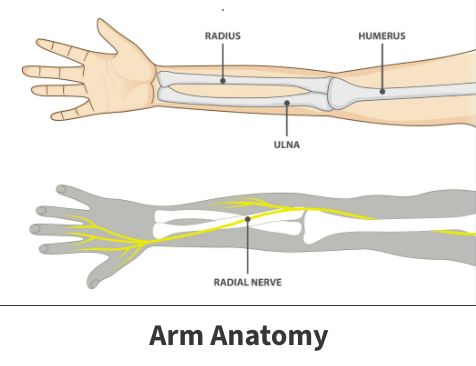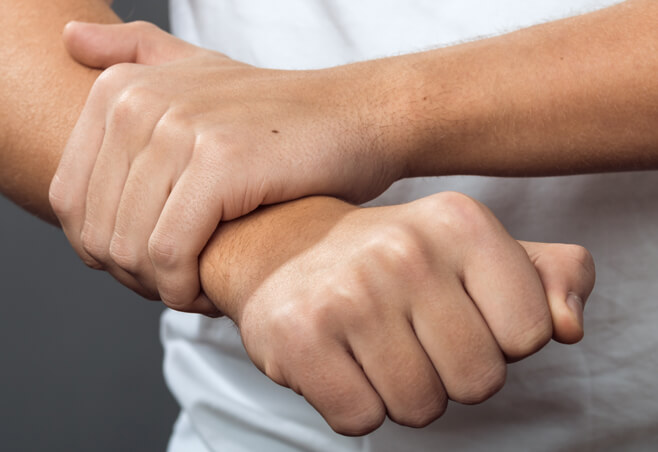Anatomy

The arms and hands contain a key component called the radial nerve. It begins in the neck and travels down the arm and into the wrist. A pathway this nerve moves through is the radial tunnel – a collection of muscle located beneath the elbow. A healthy radial nerve and tunnel are needed to ensure proper movement of the upper arm muscles and many forearm muscles.
About
Radial tunnel syndrome can be caused by repetitive or awkward arm or wrist motions and trauma.
Risk factors
One’s risk of developing this condition increases if they:
- Play sports requiring continual throwing or arm extension movements, like baseball, boxing, and basketball
- Work in a job with repetitive arm motions, like construction workers, window washers, and administrative professionals
- Are of advanced age
- Do not have flexible wrists or arms
- Have a complicating illness like cancer, thyroid disease, or diabetes
The problem can also be caused by simply leaning on your arm or elbow for extended time frames.

Symptoms
The most obvious symptom is pain, that often begins in the elbow. As the condition progresses, the pain tends to spread down the forearm. Often, lifting heavy objects, overextending the elbow, and excessive forearm rotation may worsen the unpleasant feeling.
Affected individuals may also experience redness, tenderness, and swelling on the outside of their elbow. Additionally, pain tends to grow more intense during the evening and can negatively impact one’s sleeping cycle.
Complications
If not diagnosed and treated early on, radial nerve entrapment can lead to pain in the hands and fingers, making simple actions like gripping or holding objects difficult and lessening the range of motion when twisting or extending the wrist. In the most severe instances, the problem can significantly weaken the muscles in affected arms, further limiting one’s ability to carry out common daily movements.
Diagnosis
Not one specific diagnostic test exists. A firm diagnosis could take a bit of time and examination. The diagnostic process is usually performed over several steps.
During the first phase, the doctor will ask you about your symptoms, when they started, and if any tasks worsen such problems. If they suspect radial tunnel syndrome, they will carefully check your forearm and elbow for any visible abnormalities. Following these initial stages, you might be asked to perform various resistance tests to determine the range of motion and pain tolerance levels.
Physicians may also use electromyography (EMG). EMG lets doctors determine how well the radial nerve and surrounding muscles communicate. Poor communication can show the presence of radial tunnel syndrome.
Your physician may also order internal imaging tests such as X-rays, MRI, or CT scans to capture images of the arm and elbow’s inner workings and function. They could help rule out other injuries or illnesses.
Treatment
People respond to initial home-care treatment methods. If such therapies do not produce favorable outcomes, surgery may be needed.
Nonsurgical options
Initial treatment usually involves simple corrective measures such as resting the injured arm for an extended time, using over-the-counter pain-relieving and inflammation-reducing medications, or placing the injured wrists, elbows, or forearms in movement-restricting devices like casts, braces, or splints.
More moderate cases may need therapeutic exercises designed to maintain motion ranges and prevent further weakening in the forearm muscles. Steroid injections have proven beneficial in reducing nerve sensitivity and swelling.
Surgical procedures
Only the most severe cases or those failing to respond to the previous treatments will need surgery. Those undergoing surgery will have their radial tunnels widened. This effort creates more space for the radial nerve and limits the pressure placed upon it.
Surgery is often followed by gradual physical therapy geared towards helping the recipient regain any loss of strength and mobility.
Recovery
Specific recovery times will depend on the extent of the injury and the treatment method used. Other important factors include age, general health, level of physical fitness, and if there are any other arm, elbow, or wrist illnesses or injuries.
Establishing specific time frames is often difficult as individuals heal at their own pace. Less complicated cases treated with minimally invasive methods should respond faster than those requiring surgery.
Prevention
Instances of radial tunnel syndrome caused by sudden incidents cannot typically be prevented.
One might prevent (at least limit the severity) by stretching your arms before exercise and taking frequent breaks if you are employed in a profession requiring repetitive or unusual arm movements. Above all, individuals are urged to schedule a visit with their physician if they experience associated symptoms.
Videos
Related specialties
- Arthroscopic Debridement of the Elbow
- Aspiration of the Olecranon Bursa
- Cubital Tunnel Syndrome
- Elbow Bursitis
- Elbow Injuries & Inner Elbow Pain in Throwing Athletes
- Golfer's Elbow
- Growth Plate Injuries of the Elbow
- Hyperextension Injury of the Elbow
- Little Leaguer's Elbow (Medial Apophysitis)
- Olecranon Stress Fractures
- Tennis Elbow Treatment
- Tricep Pain & Tendonitis
- UCL (Ulnar Collateral Ligament) Injuries
- Valgus Extension Overload
